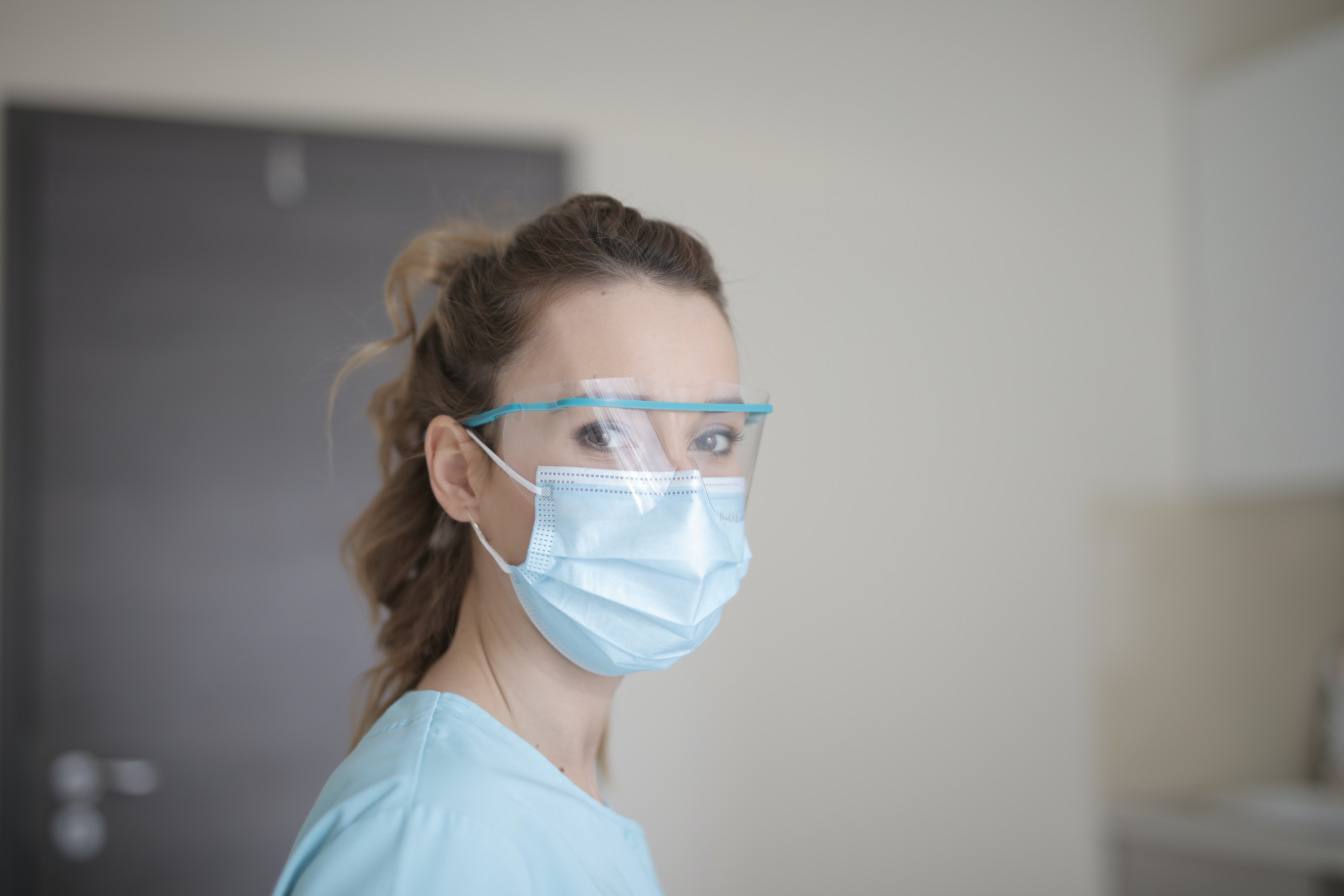
UNCA Come Together to Make PPE for Healthcare Workers
In an effort that is at once high-tech and homemade, a loose-knit group of people in the Asheville community and at UNC Asheville are working as volunteers
to fabricate and donate PPE (personal protective equipment) to health care providers in Asheville and beyond to help protect against spread of COVID-19.
Protective face shields produced by this effort are now in use on the pediatrics floor at Mission Hospital in Asheville and also are en route to Vidant Health Center, affiliated with East Carolina University in Greenville N.C.
And that’s just the beginning. Additional and more varied kinds of PPE being produced in this town/gown collaborative will soon reach farther around the region thanks to a team of UNC School of Medicine students whose clinical rotations in Asheville have been curtailed by the virus.
The Mission Hospital pediatrics team received the first batch of face shields.
NOT A FACTORY BUT A VILLAGE
This is not a one-organization effort and many of the participants have never even met each other in person. Geert Bevin, a 3D printing enthusiast and software engineer for Moog Music in Asheville, was the initiator. Aware of the global shortage of PPE and a fan of Prusa 3D printers, he went online and found that company’s publicly available 3D printer design for face shields which had been developed in concert with the Czech Republic Department of Health.
Bevin shared those plans with the nonprofit group Day One Disaster Relief, who in turn shared them with medical professionals in North Carolina for their review. “They suggested a few additions like a foam insert on the inside of the bands and a comfortable elastic strap in the back,” said Bevin. “The biggest challenge was that we needed to make and cut plastic sheets that are crystal clear to look through, that are sturdy, and easy to clean. That job required a laser cutter and that is where UNC Asheville stepped up.”
Through a Facebook connection, Bevin learned about UNC Asheville’s STEAM Studio, which has a laser cutter able to cut the plastic precisely and much more quickly than if done by hand. Bevin reached out to STEAM Studio, and STEAM’s Director Sara Sanders immediately contacted Provost Kai Campbell. He gave an enthusiastic green light, and the needed plastic material was ordered. As soon as it arrived on March 27, production began.
And while awaiting the materials, Sanders put out a call to faculty and staff who have access to 3D printers because that equipment is needed to produce the headbands and bottom reinforcements for the shields. That fabrication process is much slower than cutting the clear plastic sheets. So day and night, all over campus and in Bevin's home, 3D printers have been put to the task of fabricating the headbands and reinforcements. Soon they also will be churning out plastic nasal swabs needed to test for COVID-19, which are also in short supply.
“That’s the great thing about having this equipment and the maker-space set-up,” said Sanders. “You have the ability to be responsive and to quickly shift to making something different, as opposed to in a manufacturing facility where you’re set up to make one thing. They’re talking about having G.E. shift to making ventilators – that’s not an easy thing to do. You have to change all the equipment and get everything reprogrammed. Granted, they can make things in a much greater quantity but it takes time to get there. Spaces like STEAM, the New Media Lab and Engineering Lab on campus have a lot more flexibility and can be more nimble.”
Geert Bevin
EXPANDING THE PPE VARIETY AND RANGE
“Most of the people on campus involved in this project have SLA (stereolithography) printers which extrude a plastic bead like toothpaste which can be used to make the face-shield headbands,” explained New Media Lecturer Mark Hursty. “In the New Media Lab and the CrAFT Studio in Ramsey Library, we have resin printers which make highly detailed, almost cast-like plastic shapes and that’s where the nasal swabs will be done. Amanda Glenn-Bradley of Ramsey Library’s CrAFT Studio has taken their 3D printer to her home to work on the PPE project there. We’re also test printing some N95 cartridge-style masks that are in very short supply."
The face shields have come first, and UNC Asheville is fabricating parts for 400 face shields, most of which are being glued together and assembled by hand. STEAM Studio Technician Leslie Rosenberg has been part of STEAM’s work to cut the clear plastic sheets, and delivering parts to Bevin’s home for assembly.
Bevin’s partner Angela Kramer who also works at Moog Music, is currently staying home/staying safe and using the time and her expertise to glue and assemble the face masks by hand. “She’s got the manufacturing experience – she’s been doing it for decades in various environments,” said Bevin. “She knows how to take this on and has been bustin’ it to get these assembled and packaged. The needed materials are being paid for through a GoFundMe page and personal funds.”
Those receiving the PPE locally have picked the shields up, using social distancing, from the Bevin/Kramer home, and Bevin arranged shipment for the masks to Greenville. Now, Hursty is arranging some packets of PPE for the medical students to pick up from his home drive-through style. “Then we’re going to have a Zoom meeting to show them how to assemble them,” he said. “Then they’ll return them to campus to be sterilized either in the autoclave or UVC light disinfecting booth – Melanie Heying, manager of the Chemistry Lab is helping with that. They’ll be put in bags and the medical students will bring them to rural practices that need them.”
Kacey Scott, a UNC School of Medicine student, has recruited a team of 20 of her classmates as volunteers.
“Since our clinical rotations are canceled and we have all of this time on our hands, we are all looking for ways to help combat the pandemic,” said Scott. “Once I learned about the effort that UNCA is part of – I graduated from UNCA in December 2010 – I decided to try to help. I’m trying to find funding to support the effort, and I’m working with another med student on a needs assessment – calling medical practices in the area to get a feel for what resources they need.
“Some of the shields are more suitable for non-medical use so we may give those to people working in the community who are still sharing physical space with others as part of their jobs, like teachers handing out meals to students, or supermarket workers,” said Scott. “I’ve been in awe and really proud of the way our community has come together, volunteering not for their own profit but to help others in the community – that’s been really great.”
Others involved off campus in producing face shields include renowned artist and MacArthur “genius grant” recipient Mel Chin who has worked extensively in partnership with STEAM Studio. On campus, Associate Professor of Computer Science Kenneth Bogert and student Justin Hoilman, 3d Print Lab technician for the Department of New Media, have been producing PPE.
PPE AS HANDICRAFT OR MASS PRODUCTION?
Will even more PPE be needed with the peak of virus infection still weeks or perhaps months away? “We’re not going to be able to get any more of the clear plastic material – it’s all back-ordered at this point,” said Sanders. “But we’ll be trying to be responsive to what the need is and what our material capabilities are – trying to leverage the tools we have when we can.”
That’s exactly what Hursty is now doing. “I went into the New Media Office to the laminating machine, got 8 ½ x 11 laminating pouches, put them in the machine by themselves with no paper, let them stiffen up, and they’re a pretty good facsimile of the more durable and expensive visors,” he said. “You can affix them to the headband and it works. Will all the things we are making soon be eclipsed by larger manufacturers? You would hope. Why should we be making any of this stuff? It’s the sudden demand - we’re just doing what we can.”
“This comes back to the idea of the maker space movement – the democratization of the means of production,” said Sanders. “That’s the way things can happen quickly, through a bunch of folks coming together to make something greater than the individual can,” said Sanders. “It’s a pretty outstanding approach to community engagement. We’re having what I see as the failure of capitalism to keep people safe and healthy, and it’s great to see people responding in a way that’s really community-oriented. To my perspective, it’s way more sustainable.”


 How to resolve AdBlock issue?
How to resolve AdBlock issue? 